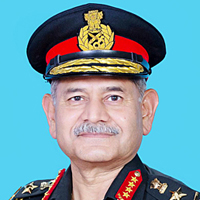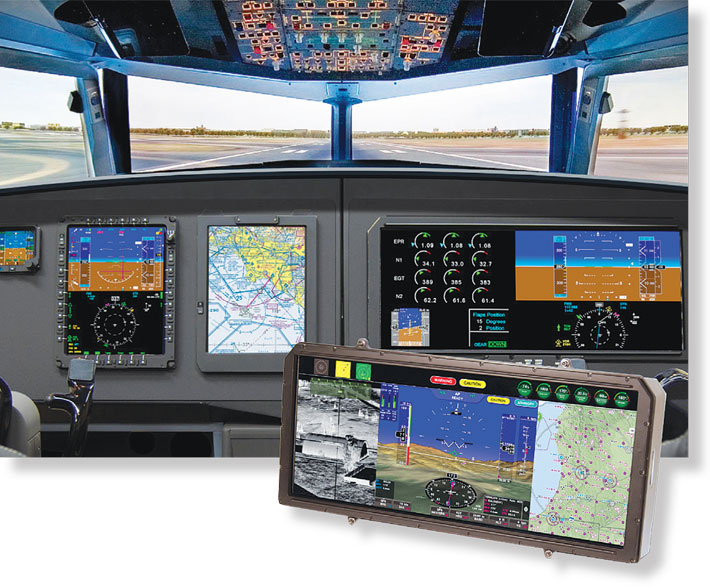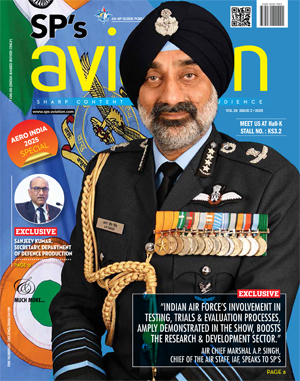INDIAN ARMED FORCES CHIEFS ON OUR RELENTLESS AND FOCUSED PUBLISHING EFFORTS

The insightful articles, inspiring narrations and analytical perspectives presented by the Editorial Team, establish an alluring connect with the reader. My compliments and best wishes to SP Guide Publications.

"Over the past 60 years, the growth of SP Guide Publications has mirrored the rising stature of Indian Navy. Its well-researched and informative magazines on Defence and Aerospace sector have served to shape an educated opinion of our military personnel, policy makers and the public alike. I wish SP's Publication team continued success, fair winds and following seas in all future endeavour!"

Since, its inception in 1964, SP Guide Publications has consistently demonstrated commitment to high-quality journalism in the aerospace and defence sectors, earning a well-deserved reputation as Asia's largest media house in this domain. I wish SP Guide Publications continued success in its pursuit of excellence.
Commited to India's Future
India-Based Design, Production and Life-Cycle Support Reflect L3’s Commitment to the Future of Indian Aviation

India is on its way to becoming the third largest civil aviation market by the year 2020 and the world’s largest aviation market by 2030, according to reports from the India Brand Equity Foundation (IBEF). Domestic air traffic is expected to exceed 100 million passengers by fiscal year 2017, up from 81 million passengers in 2015, according to the Centre for Asia Pacific Aviation (CAPA). While India is well engaged in the business of manufacturing military aircraft, it still ranks among the largest importers of military air assets — including fighter jets, helicopters, trainers, special-mission, strategic and air transport aircraft. Over the last few decades, the Government of India has made significant policy interventions to incubate and establish an aerospace manufacturing and technology development infrastructure in India. Multiple incarnations of the Defence Procurement Policy, foreign direct investment policy and most recently — the ‘Make in India’ campaign — support a drive to investment in this sector.
Traditionally, only the defence public sector units and research establishments in India were positioned to support aerospace development and manufacturing. Today, a mix of indigenous technologies, localised licence-built products and platforms, and imported systems and subsystems contribute to the production of Indian-built military aircraft. By comparison, the global industry has a multi-tier ecosystem of original equipment manufactures (OEMs), integrators and tierlevel suppliers.

With the promotion of the government’s ‘Make in India’ campaign, the Indian aviation industry is poised for growth, with opportunities and supporting policy for the localisation of design, development, production, and life-cycle support of aviation equipment and systems. With the outlook that this trend will be supported over the long term by policy evolution that drives worldclass advantages in doing business in India, industry will be set to foster an ecosystem of diverse expertise and capabilities to support the aviation industry in India.
For L3 Aviation Products & Security (L3 APS) — a global provider of commercial and military avionics products and systems — these activities can translate to partnerships, pilot programmes, and design, manufacture and localised sustainment opportunities in India. With this in mind, L3 APS established an avionics repair and overhaul facility in Bengaluru as part of its first endeavour to support customers in India through a sustainment approach. The facility has been operational since March 2015. Steps that are underway today will lead to localised manufacturing, as well as some engineering developments for L3 APS.
“L3 continues to invest in the local avionics manufacturing capability supporting Indian local demand as well as the global supply chain,” says Krishen Ganase, President of L3 APS. “As a next step, we have launched localisation activities with a ‘Make in India’ thrust to build avionics hardware and develop software for both our existing modern avionics and state-of-the-art future products.”
Among these is L3’s Modular Airborne Data Recorder/Acquisition System (MADRAS) flight data recorder, whose production and distribution activities are underway in Bengaluru. L3’s high-speed, crash-protected data recorders like the F2100/2300 MADRAS family — configured for data acquisition as a recording solution for helicopters, business aircraft, unique mission and military aircraft — are currently fielded on the HAL advanced light helicopters (ALH) and Dornier 228 aircraft, and are also standard on several of the military and civil aircraft at OEMs worldwide.
Next Steps for ‘Make in India’
“In addition to our efforts to develop, manufacture and support technology in India, L3 APS is exploring opportunities for localised industrial participation on our next-generation Large Area Multi-Function Cockpit Display technology — PANTHR™,” says Group Captain Rajeev Dutta (Retd), L3 APS Director of Business Development, India.
As a key supplier for avionics products and solutions, L3 continues to build a subcontractor partnership base in India that will serve both the Indian market and the global supply chain. Dutta adds, “Broad skills and competencies so developed and harnessed across India will serve the country more efficiently in building a high-quality ecosystem. This will also optimise our time-to-market and support of our products, as we aim to be a true India partner, today, tomorrow and in the future.”
ADS-B and Next-Gen Readiness in India
With rapid growth in the air transportation and the new National Civil Aviation Policy, there is an urgency to be ready in the near future for increased traffic — and flexible/optimal use of airspace as a resource. The International Civil Aviation Organisation (ICAO) has recommended priority areas that will benefit the region through optimised operations and increased safety. In focusing on infrastructure upgrades, India has equipped 22 airfields with Automatic Dependent Surveillance-Broadcast (ADS-B) ground stations and multilateration technology covering most of the Indian land mass. In addition, the GAGAN (Indian-based GPS augmentation system) is available for operation.
Dutta affirms that as an industry leader, L3 was the first to certify the compliant DO-260B ADS-B transponder technology, enabling compliance and enhanced safety. L3’s certified, nextgeneration DO-260B products span all aircraft types, from general aviation (GA) to military and commercial air transport. “L3 was also first to market with SafeRoute™ — our full range of ADS-B In safety and operational efficiency enhancement applications,” says Dutta. “As a safety and surveillance solution, SafeRoute™-derived applications are compliant with several ICAO APAC region Aviation Block System Upgrades and are available on airliners here in India and around the world,” he adds.
Affordable Next-Gen System for General Aviation
For India’s expanding general aviation and helicopter segments, L3 offers a smaller, lighter, feature-rich Lynx® family of multi-link transponders, which offers a range of ADS-B In/Out solutions. This technology provides several benefits to the GA community by providing traffic information on par with traffic awareness systems and interoperability with the multilateration environment at air traffic control points.
In keeping with L3’s focus on ‘Make in India,’ the Lynx family of products includes key technology content developed in India by one of L3’s key partners. The product line is now certified and was successfully introduced into the global aviation market in 2015.





